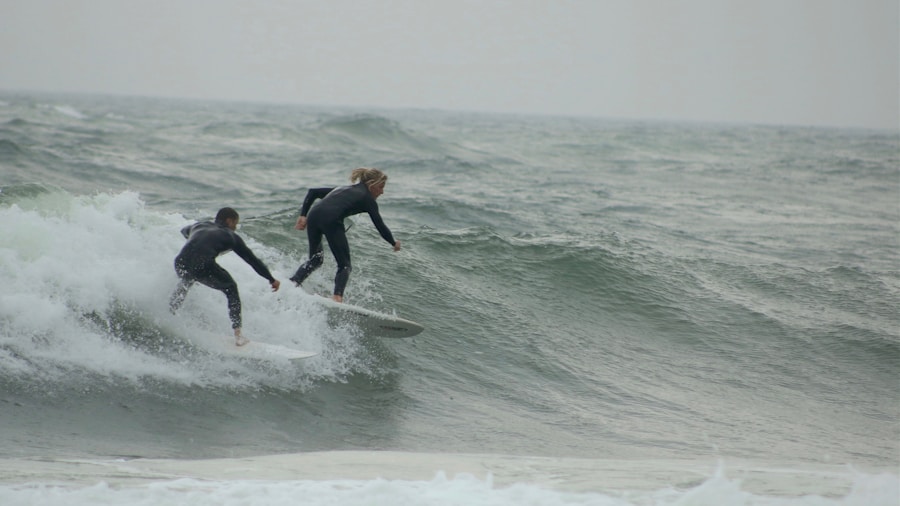Download links
How to install Surfing Makes Historic Debut at Olympics APK?
1. Tap the downloaded Surfing Makes Historic Debut at Olympics APK file.
2. Touch install.
3. Follow the steps on the screen.
Description
The journey of surfing towards Olympic inclusion is a tale of passion, perseverance, and a deep-rooted connection to the ocean. Surfing, which originated in ancient Polynesia, has evolved into a global phenomenon, captivating millions with its blend of athleticism and artistry. The push for surfing to be recognized as an Olympic sport gained momentum in the early 21st century, driven by the International Surfing Association (ISA) and a growing community of surfers who believed that the sport deserved a platform on the world stage.
In 2016, the ISA’s efforts culminated in a significant milestone when the International Olympic Committee (IOC) officially recognized surfing as an Olympic sport, paving the way for its debut at the Tokyo 2020 Games. The inclusion of surfing in the Olympics was not merely a matter of showcasing a sport; it represented a broader cultural acknowledgment of surfing’s significance. The IOC’s decision was influenced by several factors, including the sport’s increasing popularity among youth and its alignment with the Olympic values of excellence, friendship, and respect.
The dynamic nature of surfing, characterized by its vibrant lifestyle and community ethos, resonated with the IOC’s vision of modernizing the Games to attract younger audiences. As a result, surfing was slated to make its Olympic debut alongside other sports like skateboarding and sport climbing, marking a new era for the Olympics that embraced action sports and their unique cultures.
Key Takeaways
- Surfing’s journey to Olympic inclusion was a long and challenging process, but it finally earned its place in the Games in 2016.
- Tsurigasaki Beach in Chiba, Japan, will be the venue for the surfing competition at the Olympics, providing a picturesque and challenging setting for the athletes.
- The surfing competitors making history at the Olympics come from diverse backgrounds and have unique stories, but they all share a passion for the sport and a drive to succeed on the world stage.
- Understanding the judging criteria for surfing at the Olympics is crucial for both athletes and spectators, as it will determine the scores and ultimately the winners of the competition.
- The inclusion of surfing in the Olympics is expected to have a significant impact on the sport’s future, influencing everything from participation levels to sponsorship opportunities and global recognition.
- The future looks bright for surfing, as its inclusion in the Olympics is likely to lead to increased global growth and interest in the sport, opening up new opportunities for athletes and fans alike.
The Surfing Venue: A Look at Tsurigasaki Beach in Chiba, Japan
Tsurigasaki Beach, located in Chiba Prefecture, Japan, was chosen as the venue for surfing events during the Tokyo 2020 Olympics. This picturesque stretch of coastline is renowned for its consistent waves and scenic beauty, making it an ideal location for surfers from around the globe. The beach is situated approximately 60 kilometers east of Tokyo and is easily accessible, allowing both local and international spectators to witness the thrilling competition firsthand.
Tsurigasaki’s selection as the Olympic surfing venue reflects not only its natural attributes but also Japan’s deep cultural connection to the ocean. The beach itself is characterized by its sandy shores and rolling waves, which vary in size and intensity depending on weather conditions. This variability adds an element of unpredictability to the competition, as athletes must adapt their strategies to the ever-changing surf.
Tsurigasaki Beach has hosted numerous national and international surfing competitions prior to the Olympics, establishing itself as a respected location within the global surfing community. The local government has invested in infrastructure improvements to accommodate the influx of visitors during the Games, ensuring that both athletes and spectators have a memorable experience.
The Athletes: Profiles of the Surfing Competitors Making History at the Olympics

The inaugural Olympic surfing competition featured a diverse array of athletes from various countries, each bringing their unique styles and backgrounds to the water. Among them was Carissa Moore from Hawaii, a three-time world champion known for her powerful and graceful surfing technique. Moore’s journey to the Olympics was marked by her relentless dedication to the sport and her desire to inspire young female surfers around the world.
Her presence at Tsurigasaki Beach symbolized not only her personal achievements but also a significant step forward for women’s representation in competitive surfing. Another standout competitor was Gabriel Medina from Brazil, who made waves in the surfing world with his innovative maneuvers and competitive spirit. Medina’s rise to prominence has been meteoric; he became the first Brazilian to win a World Surf League title in 2014 and has since become a role model for aspiring surfers in his home country.
His participation in the Olympics was seen as a testament to Brazil’s growing influence in the sport and highlighted the global nature of competitive surfing. Both Moore and Medina exemplified the dedication and skill required to excel at this elite level, showcasing the rich tapestry of talent that exists within the surfing community.
The Judging Criteria: Understanding How Surfing will be Scored at the Olympics
| Criteria | Description |
|---|---|
| Wave Selection | The ability to choose the best waves with the most scoring potential |
| Speed and Power | The speed and power displayed during maneuvers on the wave |
| Maneuvers | The variety, execution, and progression of maneuvers performed on the wave |
| Flow and Control | The smoothness, flow, and control demonstrated throughout the ride |
| Risk and Innovation | The degree of risk taken and the innovation displayed in the performance |
Surfing competitions are unique in their scoring systems, which aim to evaluate not only technical proficiency but also creativity and style. At the Olympics, judges assess each surfer’s performance based on several criteria, including wave selection, difficulty of maneuvers, variety of tricks executed, and overall flow of the ride. Each surfer is given two scores: one for their best wave and another for their second-best wave.
This dual scoring system encourages athletes to take risks and push their limits while also rewarding consistency. The judging panel typically consists of five judges who score each performance on a scale from 0 to 10.
This method aims to minimize bias while ensuring that each surfer’s performance is evaluated fairly. Additionally, judges are trained to recognize specific maneuvers that demonstrate technical skill, such as aerials or tube rides, which can significantly impact a surfer’s overall score. Understanding these criteria is crucial for athletes as they prepare for competition; they must not only master their techniques but also develop an intuitive sense of how to impress judges while riding waves.
The Impact on the Surfing Community: How the Olympics will Influence the Sport’s Future
The inclusion of surfing in the Olympics is poised to have profound implications for the sport’s future. For many within the surfing community, this recognition represents validation of their passion and dedication. It has already sparked increased interest among young athletes who aspire to compete at an elite level.
Surf schools and training programs are likely to see a surge in enrollment as aspiring surfers seek to hone their skills in hopes of one day representing their countries on an Olympic stage. Moreover, Olympic inclusion can lead to greater investment in infrastructure and resources dedicated to surfing. National governing bodies may allocate more funding towards developing talent pipelines, coaching programs, and facilities that support surfers’ growth.
This could result in enhanced opportunities for underrepresented communities within surfing, fostering diversity and inclusivity in a sport that has historically been dominated by certain demographics. As more countries invest in their surfing programs, we may witness an expansion of competitive events worldwide, further elevating surfing’s profile as a legitimate sport.
The Road Ahead: What the Inclusion of Surfing in the Olympics Means for the Sport’s Global Growth

Global Growth and Cultural Exchange
Surfing’s inclusion in the Olympics marks a pivotal moment that could catalyze global growth for the sport. As more nations embrace competitive surfing, we can expect an increase in international competitions that showcase emerging talent from diverse backgrounds. This expansion will not only elevate individual athletes but also promote cultural exchange among nations through shared experiences in competition.
New Commercial Opportunities
Furthermore, with increased visibility comes greater commercial opportunities for surfers and sponsors alike. Brands associated with surfing may find new avenues for marketing and engagement as they align themselves with Olympic athletes who embody the spirit of adventure and athleticism. This could lead to enhanced sponsorship deals and partnerships that support both athletes’ careers and grassroots initiatives aimed at growing participation in surfing globally.
A Bright Future Ahead
In conclusion, while challenges remain—such as environmental concerns related to coastal ecosystems—the future looks bright for surfing as it rides this wave of Olympic recognition. The sport stands at a crossroads where tradition meets modernity, offering exciting possibilities for athletes, fans, and communities worldwide. As we witness this evolution unfold, it becomes clear that surfing is not just a sport; it is a way of life that continues to inspire generations across oceans and borders.
Surfing enthusiasts around the world are eagerly anticipating the sport’s debut at the Olympics. The inclusion of surfing in the prestigious event has been a long time coming, and many are excited to see how the world’s best surfers will fare on the international stage. For more information on the science behind surfing and how it can benefit athletes, check out this fascinating article on outlook.science.
FAQs
What is surfing in the Olympics?
Surfing is a sport that involves riding ocean waves on a surfboard. In the Olympics, surfing is a competitive event where athletes showcase their skills in riding waves.
When was surfing introduced to the Olympics?
Surfing was introduced to the Olympics for the first time in the 2020 Tokyo Olympics. It was included as part of the Games’ efforts to attract a younger audience and promote more diverse sports.
How is surfing judged in the Olympics?
Surfing in the Olympics is judged based on the athletes’ ability to perform maneuvers on the waves, their style, and their overall performance. Judges consider factors such as speed, power, and flow in their scoring.
What are the rules and regulations for surfing in the Olympics?
The rules and regulations for surfing in the Olympics are set by the International Surfing Association (ISA) and the International Olympic Committee (IOC). These rules cover aspects such as wave selection, time limits, and judging criteria.
Which countries are known for their strong surfing teams in the Olympics?
Countries with strong surfing traditions, such as Australia, the United States, Brazil, and Hawaii, are known for their competitive surfing teams in the Olympics. These countries have produced many world-class surfers who have excelled in international competitions.
What are the different events in surfing at the Olympics?
In the Olympics, surfing consists of men’s and women’s individual events, where athletes compete in heats to advance through the rounds. The competition takes place at a designated surf break, and athletes are judged based on their performance in the waves.





